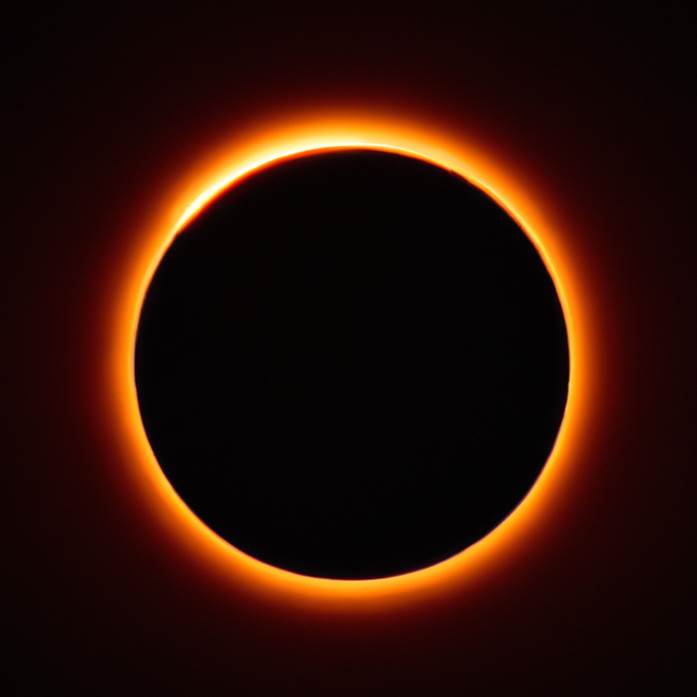
The 2023 Annular Solar Eclipse: A Technical Guide to Safe Viewing
Decoding the Annular Solar Eclipse
On October 14, 2023, the astronomical community and enthusiasts alike will be treated to a mesmerizing Annular Solar Eclipse. Distinguished from a total solar eclipse, an Annular Solar Eclipse occurs when the moon’s apparent diameter is smaller than the sun’s. This results in the sun appearing as a very bright ring, or annulus, surrounding the dark disk of the moon.
The 2023 Spectacle: What to Expect and Where to See It
This year's Annular Solar Eclipse will traverse a path across North, Central, and South America. While many regions will witness a partial eclipse, certain areas will experience the full glory of the "ring of fire". The path of annularity will stretch impressively wide, covering up to 225 km (about 140 miles) in breadth. At its zenith, the eclipse will obscure almost 91% of the sun, with the maximum annular phase lasting for up to 5 minutes.

The "ring of fire" as the moon covers up to 91% of the sun
For those marking their calendars and planning their viewing spots, here's a breakdown of the eclipse's journey:
- Oregon, USA: The eclipse first touches land here at 09:13 PDT.
- Texas, USA: The shadow will continue its south-westerly path and will exit the Texas boundary at 12:03 CDT.
- Mexico: As the eclipse continues its trajectory, it will grace the skies of Mexico.
- End Point: The annular spectacle will conclude its terrestrial journey at 16:48 BRT.
This celestial event offers both casual observers and astronomy enthusiasts a chance to witness one of nature's grandest spectacles. Remember to gear up with the right equipment to capture the event in its entirety.
Fun Activity: If you have a thermometer or weather station, be sure to record the outside air temp before, during and after the eclipse. You should see a dip in the temperature. You should also notice birds go eerily quiet as the light intensity reduces. Although your eyes may adjust for this, birds do notice and settle down.

Temp recordings from the UK during a partial solar eclipse March 2015 showing temperature drop during the event.
Prime North American Locations:
- Northern California, USA: Cities like Redding and Eureka will be some of the first to witness the annular phase of the eclipse. Expected peak annularity is around 9:45 AM PDT.
- Oregon, USA: Cities such as Medford and Grants Pass will see the eclipse reaching its maximum at approximately 9:40 AM PDT.
- Nevada, USA: In locations like Reno, the ring phase will be observable around 9:42 AM PDT.
- Idaho, USA: Cities like Twin Falls are expected to witness the peak around 9:43 AM MDT.
These mentioned times are approximate and are centered around the peak of the annular phase. The eclipse's start and end times will be roughly an hour before and after the peak, respectively.
Those outside of these prime viewing locations can still expect a breathtaking partial eclipse, with a significant portion of the sun obscured by the moon. Remember, whether you're in a prime location or not, the importance of proper viewing equipment cannot be stressed enough!

Partial solar eclipses are still breathtaking.
The Importance of Safe Eclipse Viewing
Direct observation of the sun, even during an eclipse, can cause irreversible eye damage. The intensity of sunlight, combined with the heightened curiosity during such events, necessitates specialized equipment for safe viewing. Remember, it is crucial to follow the manufacturer's instructions and guidelines when using Baader Planetarium products or any other solar viewing equipment. Safeguard your eyes by never looking directly at the Sun without proper protection. To make the most of the solar eclipse, consider finding a suitable location along the path and plan your viewing experience well in advance.
We recommend using Baader Planetarium products for safe solar observing or photography. Baader Planetarium have been producing products for solar observation for more than 25 years and producing astronomical instruments for over 50 years. If they had not been doing this right, they wouldn’t be in business.
Baader Planetarium are listed on the AAS website American Astronomical (AAS) Website (links below) as an official manufacturer meeting international standard for Baader's AstroSolar Silver/Gold Film, meeting the transmittance requirements of the ISO 12312-2 international standard for filters for eyes-only direct viewing of the everyday Sun.
Your First Line of Defense: The Baader Solar Viewer (Solar Glasses)
The Baader Solar Viewer glasses (Baader Planetarium Solar Viewer AstroSolar® Silver/Gold), available at Alpine Astro, is a staple for eclipse chasers. Designed by the esteemed Baader Planetarium, its AstroSolar Silver-Gold film shields your eyes from harmful solar radiation while ensuring a clear view of the event. They're available in various pack sizes to suit individual or group needs.
Baader Planetarium Solar Viewer AstroSolar® Silver/Gold are ISO 12312-2:2015 certified and are:
- 100% safe for eyes-only solar observation
- 100% UV-protection
- 100% IR-protection
- 99.999% reducing sun light intensity
View the Baader Solar Viewer here.
For the Telescopically Inclined: Baader Solar Filters
If you're using a telescope to observe the Annular Solar Eclipse and photograph it, equipping it with the right solar filter is crucial. Alpine Astro offers Baader Solar Filters that fit securely over the front of your telescope. These filters minimize the sun's intense brightness, allowing for detailed observations of the sun's surface phenomena and the moon's passage without risking eye damage.
As stated on the AAS website, although Baader AstroSolar Safety Film transmits slightly more ultraviolet light than the ISO 12312-2:2015 standard allows - it has been safely used by amateur and professional astronomers for several decades for observing and/or imaging the Sun through telescopes, binoculars, and camera lenses, whose glass elements filter out the excess ultraviolet light.
Check out Baader Solar Filters here.
We've Got You Covered: AstroSolar Films
The AstroSolar Photo Film OD 3.8 is meticulously engineered to protect camera sensors while ensuring high-quality solar imaging. Don't use this for visual observing.
For diverse applications, the AstroSolar Safety Film OD 5.0 is the go-to. Whether for telescopic viewing, binoculars, or crafting custom sun viewers, this film ensures top-notch safety and clarity.
Wrapping Up: Safety Meets Precision
The upcoming Annular Solar Eclipse is more than just a visual treat; it’s an opportunity for scientific observation and appreciation. Dive into the 2023 Annular Solar Eclipse with Alpine Astro's specialized products. Prioritizing both clarity and safety, our range ensures an unparalleled viewing and photography experience. Prepare now for the celestial event of the year.
Links
AAS Website: https://eclipse.aas.org/resources/solar-filters
Baader Solar Viewer: https://alpineastro.com/products/solar-viewer-astrosolar%C2%AE-silver-gold-1pc-10pc-25pc-100pc
Baader Solar Telescope Filters: https://alpineastro.com/collections/baader-solar-filter
Baader AstroSolar Safety Film: https://alpineastro.com/collections/astrosolar-viewers-and-film





Leave a comment